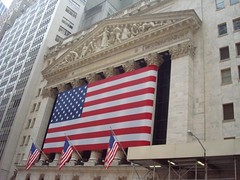| New York Stock Exchange (Photo credit: inkwellmusings) |
New highs were also made in Germany and Japan’s stock markets. Low interest rates and solid earnings gains in the United States fueled the rallies there. But despite the optimism, the public is still focused on investment-grade bonds. According to Thomson Reuters, in the first 17 weeks of 2013, investors bought a record $55.2 billion in bond funds and $54.5 billion of domestic equity funds.
At the close, the Dow Jones Industrial Average gained 87 points at 15,056, the S&P 500 rose 8 points to 1,626, and the Nasdaq rose 4 points to 3,397. The NYSE traded 636 million shares and the Nasdaq crossed 340 million. On the Big Board, advancers exceeded decliners by 2.6-to-1, and on the Nasdaq, advancers were ahead by 1.7-to-1.
On Tuesday, the Dow industrials finally closed above 15,000 for the first time ever. And by closing very close to their high of the day exhibited the power of the breakout and the likelihood of a continuation of the advance. Profit-taking should initially hold at the support line at 14,887, then the 20-day moving average at 14,758, and the 50-day moving average at 14,556.
And what could make a follower of Dow Theory any happier than a new high close on the Dow Jones Transportation Average on the same day as a new high in the industrials? Tuesday’s Dow action is called a “Dow bull market confirmation,” and means that the bulls are firmly in charge of the stock market.
Conclusion: There is much to cheer about technically. As illustrated, Dow Theory issued a powerful new buy signal Tuesday. Group rotation has recently been on an upswing with the technology stocks getting most of the attention last week and banks being at the top of buyers’ lists Tuesday.
Defensive sectors like utilities, health care, telecommunications and consumer staples have so far led this year’s advance. But the recent buying in technology, industrials and energy is healthy since those sectors make up 40% of the S&P 500.
In other words, this year’s gain of almost 14% has been fueled by only 60% of stocks in the S&P 500. This also may explain why the advance has been accompanied by lower-than-average volume — the public is still afraid to make a leap of faith. And the fear is well illustrated by the previously mentioned report from Thomson Reuters that a record number of bond funds have been bought, exceeding the purchase of domestic equity funds.
As long as the public is unconvinced that the bull is on a run, he will continue leaping to higher pastures..





No comments:
Post a Comment